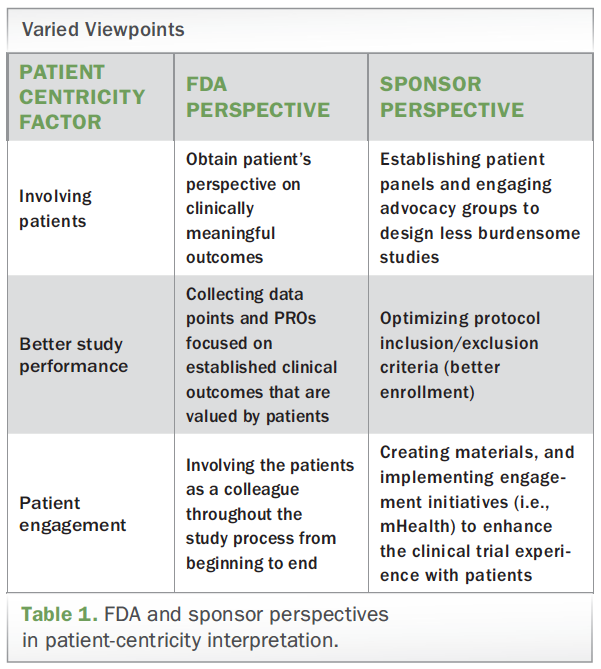The Evolution of Patient Centricity
Applied Clinical Trials
Examining the distinct actions and advocacy that have advanced the concept from buzzword status to practical implementation in clinical studies.

Since we started reporting on the topic of patient centricity back in 2014, we’ve kept track of how the subject has evolved. Initially, there were many perspectives on what patient centricity was until the FDA started to evangelize its outlook on the matter. Nonetheless, the topic continues to present new opportunities with the emergence of digital health and is even propagating to smaller biopharmaceutical enterprises. In this article, we will discuss the start and evolution of patient centricity.
The start of patient centricity
While the FDA was working on the Patient-Focused Drug Development Initiative (since 2012),1 the first time we heard about patient centricity was during former FDA Commissioner Margaret Hamburg’s 2014 speech at New York BIO.2 During this speech, Dr. Hamburg elaborated on how the FDA had meetings with patients and patient advocates to discuss certain diseases, and how these diseases impacted patient lives. This effort allowed the FDA to understand diseases better, and how to develop more effective and user-friendly medical interventions. This initiative sparked a new wave that shaped the way the industry currently engages and involves patients in drug development.
Patient centricity: What you see is all there is
Despite the vagueness of patient centricity, the biopharmaceutical industry wasted no time and started discussing their perspectives about patient centricity at industry symposia.3 Most perspectives circled one theme: to involve patients in studies. The definition of “involvement,” however, differed between various industry leaders and service providers.4 To some, patient centricity meant providing patients better access to finding studies, or using technology and mHealth5 to make studies more convenient and “centric” to patients, whereas to others, patient centricity meant reducing patient burden by obtaining data from patient medical records. For example, GlaxoSmithKline executed the Salford Lung Study6 to evaluate chronic obstructive pulmonary disease (COPD) exacerbations with Breo Ellipta in real-world settings; rather than requiring patients to adhere to the confinements of clinical trial constraints, GSK integrated into electronic medical record systems to collect endpoint-related data.
FDA steps in to define patient centricity
In 2016, the FDA evangelized how it perceived patient centricity and clarified industry misconceptions.7 According to our reporting with FDA, the industry wasn’t involving the patient during the entire drug development process, and that the industry should focus on why they are bringing drugs to market, incorporating patient diversity, and generating outcomes meaningful to patients. FDA suspected the disconnect in patient centricity interpretations arose from C-suite level personnel within the biopharmaceutical industry. Table 1 illustrates these differences.

Industry aligns messaging with FDA and focuses on industry-specific needs
In the following year, we started to see the emergence of perspectives that aligned more closely with FDA. For example, Novartis described patient centricity as “understanding the patient and the impact that we have and that we want to have on their lives…and where our therapeutic interventions can make a real difference.”8 Novartis pushed industry definitions by elaborating that patient centricity also involved reducing patient burden (i.e., eliminating unnecessary clinic visits or bringing the trial entirely to the patient’s home), while also reinforcing the desire to engage, inform, empower, and thank patients for participation, and focused on incorporating digital health initiatives in studies.
Similarly, Boehringer Ingelheim focused on investigating patient-centric efforts on remote trials, including leveraging digital opportunities (i.e., internet, social media, etc.) to recruit patients; using eConsent; collecting data remotely via biosensors; eMonitoring (i.e., leveraging risk-based monitoring on collected data); utilizing technology to engage patients (i.e., digital reminders, and digital access to study information); and pointed to a federal register docket on use of digital technology in clinical trials.9 In essence, BI was homing in on these initiatives to align its clinical trials with future patients, who will expect convenience and remoteness in study conduct. Service providers have also aligned with industry needs by tagging patient centricity with concierge services, such as Lyft rides to study visits.10
Patients reveal some evidence of industry alignment with FDA
While patients have suggested alignment with industry-led patient- centric initiatives11 by demanding convenience (i.e., remote study visits), incorporating digital health in study procedures, requiring sponsors to provide more information about study procedures, and designing protocols with the patient in mind, they have also indicated strong support that the industry is aligning with FDA patient-centric definitions by involving patients throughout the drug development process. For example, sponsors are offering genomic sequence data to patients through portals and hosting quarterly webinars to answer study-related questions. Shelly Hoover, an ALS patient, stated, “by bringing me in the process and sharing information with me, I feel like I am a more valuable contributor because I can see that what I am doing is making a difference and that the data is valuable to the people who are gathering it.”
Digital health influences patient centricity
With advances in digital health, sponsors started to take the initiative by piloting studies that support the creation of tools for patient centricity. For example, Amgen launched a fully remote clinical trial using eConsent, Apple Watch, and electronic patient-reported outcomes (ePROs) to study a digital biomarker for migraine.12 Additionally, with FDA’s Digital Health Innovation Action Plan and the Pre-Cert program,13 service providers have emerged with a sole focus on advancing remote trials and are linking such services with patient centricity.14
An evolving target, but gaining ground
In this article, we discussed the evolution of patient centricity over the past five years. The concept morphed from numerous theories into distinct, yet evolving approaches driven by the industry and regulators. It appears that the industry is starting to incorporate FDA’s perspectives of patient centricity in studies (i.e., patient involvement throughout the drug development process), and the industry is pushing its own initiatives that focus on bringing clinical trial convenience to patients via digital methods. We forecast that digital health will continue to influence patient centricity, as these technologies will allow studies to become more remote, hence, reducing patient burden. Additionally, we see that patient centricity will become a normal process in the biopharmaceutical industry, as smaller enterprises15 are starting to employ patient-centric approaches in drug development.
Moe Alsumidaie, MBA, MSF, is a thought leader and expert in the application of business analytics toward clinical trials, and Editorial Advisory Board member for and regular contributor to Applied Clinical Trials
References
- https://www.fda.gov/ForIndustry/UserFees/PrescriptionDrugUserFee/ucm347317.htm
- http://www.appliedclinicaltrialsonline.com/fdas-margaret-hamburg-angle-patient-engagement-and-regulatory-systems-reform
- http://www.appliedclinicaltrialsonline.com/whats-all-talk-about-patient-centricity
- http://www.appliedclinicaltrialsonline.com/patient-centricity-panel-expert-opinion
- http://www.appliedclinicaltrialsonline.com/clinical-trial-site-centricity-vs-patient-centricity-what-s-more-compatible-model
- http://www.appliedclinicaltrialsonline.com/gsk-addresses-clinical-outcomes-through-patient-centric-studies
- http://www.appliedclinicaltrialsonline.com/fda-s-john-whyte-industry-does-not-fully-grasp-patient-centricity
- http://www.appliedclinicaltrialsonline.com/novartis-brings-digital-trial-patient-centricity-0
- https://www.federalregister.gov/documents/2015/10/29/2015-27581/using-technologies-and-innovative-methods-to-conduct-food-and-drug-administration-regulated-clinical
- http://www.appliedclinicaltrialsonline.com/patient-centricity-and-convenience-request-lyft
- http://www.appliedclinicaltrialsonline.com/what-patient-centricity-means-patient
- http://www.appliedclinicaltrialsonline.com/amgen-explores-patient-centricity-mhealth-migraine-clinical-trial
- https://www.fda.gov/medicaldevices/digitalhealth/digitalhealthprecertprogram/default.htm
- http://www.appliedclinicaltrialsonline.com/navigating-use-digital-health-virtual-trials
- http://www.appliedclinicaltrialsonline.com/patient-centricity-improving-study-outcomes-small-pharma

Newsletter
Stay current in clinical research with Applied Clinical Trials, providing expert insights, regulatory updates, and practical strategies for successful clinical trial design and execution.
Unifying Industry to Better Understand GCP Guidance
May 7th 2025In this episode of the Applied Clinical Trials Podcast, David Nickerson, head of clinical quality management at EMD Serono; and Arlene Lee, director of product management, data quality & risk management solutions at Medidata, discuss the newest ICH E6(R3) GCP guidelines as well as how TransCelerate and ACRO have partnered to help stakeholders better acclimate to these guidelines.